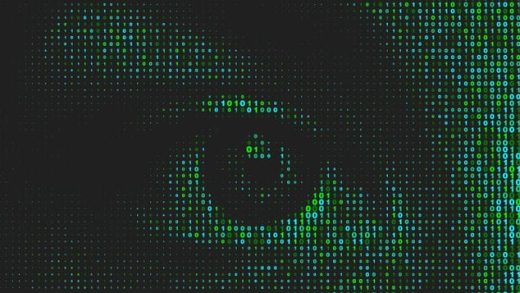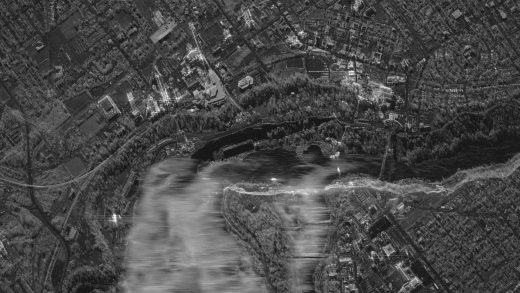I’ve been watching the Extremely Sad Show for Extremely Sad People for a few months now. I only learned this a few weeks ago, though.
At an editorial meeting for the literary magazine where I’m a columnist, someone said she was watching “the extremely sad show for extremely sad people.” Another editor immediately asked, “You mean The Leftovers?” Though she wasn’t watching the series, I was, and everyone agreed that this encapsulated the show’s ethos. The HBO adaptation of Tom Perrotta’s 2011 novel The Leftovers tracks the lives of people in small town Mapleton, New York after 2% of the world’s population spontaneously vanishes on October 14, in what comes to be known as the Sudden Departure. Both the show and Perrotta’s novel follow an ensemble cast, documenting how an array of people respond to the disappearance of their friends, neighbors, lovers, children, entire families.
The Sudden Departure explodes in visual chaos. Drivers disappear, horns honk, cars crash, people scream, fires ignite. A mother screams that her baby is gone. But the Garvey family, comprising the majority of the show’s central cast, remains intact. Nobody vanishes on October 14. Yet, through the chaos they splinter; the mother, Laurie, to a cult called the Guilty Remnant; the son, Tom, to Holy Wayne, a man who claims he can hug away people’s pain; the daughter, Jill, to the bad kids at school; and the father, Kevin, to nowhere in particular, trying to hold on but struggling, blacking out at night and shooting feral dogs with another man from town.
The Leftovers exists in a world of bleak magic. At first, those left behind wonder where those lost went—did god bring them home? Are those who departed sinners or saints? Are they coming back?—but as time without them accumulates, everyone must find some new organizing logic, a higher principle to explain the disaster. Seeking to compartmentalize the chaos—the ineffability—of the Sudden Departure, communities turn to drinking, cults, and Holy Wayne. In Mapleton, members of the Guilty Remnant take a vow of silence, dress in all white, and chain smoke in pairs, watching–or, more accurately, stalking–people that return to some semblance of ordinary life. These acts of theater are meant to force the public to remember that those lost are not returning. The show becomes this cross-section not just of the wreck but of the community picking through it. What will each person latch onto to find a way through this world where the rules they understood no longer apply?
What will each person latch onto to find a way through this world where the rules they understood no longer apply?
While coping responses to disaster in The Leftovers are spectacular, those that rose to the surface of social media last March were overwhelmingly banal. People at home turned to the mundane to respond to the highly explicable but still unexpected Covid pandemic: sourdough, banana bread, Animal Crossing. These were concrete, snow-day activities, things to do to wait out a few weeks on pause. An extrovert, I found myself lying on the floor with no idea what to do. My world had shrunk to my boyfriend and me. We taught classes asynchronously and watched case numbers rise. At the end of April 2021, the New York Times reported close to 574,000 deaths from Covid-19 in the United States. We lived through day after day when the lives lost surpassed casualties in hurricanes, war, and attacks. This wasn’t so sudden, but a year of adjustment.
I only began watching the show in December. At my parents’ house for the holidays, I was convalescing from a pandemic breakup. Somehow, I found myself in the basement with my sister, doing a puzzle and watching The Leftovers. My old roommate had binged the entire series while I was traveling for work for two weeks. When I returned, she was in some sort of funk. I bookmarked the show, but it fell from my mind. Drifting through my parents’ house, crying, barely eating, I thought of it again; what I knew of the show seemed to match my newly single emotional landscape. Beginning the series was some sort of decision I could make for myself.
The pilot portrays a bleak, sexy what-if of a world making sense of disaster. Jill Garvey goes to a party where they use an app to play a masochistic spin-the-bottle, challenging friends to self-harm or pair off and hook up. A strange cult dressed in white protests a local memorial leading to a town-wide brawl. The pilot had me hooked.
Beyond its edginess, though, The Leftovers provided me with something for myself. My relationship had guided me through the pandemic. How would I weather the rest of this time in isolation alone? Navigating the aftermath of the Sudden Departure, the residents of Mapleton illustrate various roadmaps through unexpected loss. This is how to be alone. This is how to pull through chaos. This is how to determine who to become next.
This is how to be alone. This is how to pull through chaos. This is how to determine who to become next.
I was magnetized to Kevin Garvey. Sure, Justin Theroux is at his best in the series, and maybe he became my newfound fashion icon and celebrity crush. Whereas everyone else in his family makes clear changes to metabolize grief, Kevin is adrift.
When we meet him, we can see that he has struggled attaching to a new guiding logic. Kevin holds onto the past. He honors the memory of those lost when he teams up with the mayor. He lashes out when Laurie serves him divorce papers. His life is riddled with dreams, spectral dogs, blackouts. Is he coming to reckon with the schizophrenia that seems to afflict his father or are there cosmic beings, ghostly impressions that haunt him through his unraveling? It’s a common horror trope—is the haunting “real” or is it a manifestation of psychological distress? Yet in The Leftovers, there’s a blurry duality to everything: it might be both. People live in dialectics. Maybe we do have reason to believe in higher powers. There could be something cosmic, magical organizing destruction with a vision we cannot perceive. In the show’s first season, Kevin doesn’t find any answers. He finds himself divorced and sinking deeper into the tangles of his mind. His family members appear resolute in their new decisions, but Kevin seems to accept how he doesn’t have it together. He has already come to terms with how he’s not a good person. At the show’s beginning, he’s not much better, just more aware of his faults. Loss forces him to see himself again.
In an early episode, he meets Nora Durst, a woman who lost her husband and two young children on October 14 (and played by a cool and guarded Carrie Coon). She reveals that her departed husband cheated on her, and Kevin admits he also cheated. When she asks why, he says that there’s never a good reason. Shortly after, they start seeing each other. He and Nora have both lost so much and try to find a way to be intimate, to connect closely with another person once more. Kevin is someone who depends on others: Jill for human connection, Laurie for eventual psychiatric support. Maybe Nora will give him a new guiding purpose, a challenge. She pushes him in ways he doesn’t expect. For Kevin, this relationship could be significant. Embracing romantic possibility with Nora, he can take the next step into this uncertain future.
In therapy, I’m working through the ways I’m codependent with others. Life through the pandemic and my recent breakup brought about a more acute realization of my tendencies. My therapist gave me an inventory of codependent behaviors. I looked back on everything. There were times last winter when I’d go to yoga by myself, opening my eyes at the end of class and feel fundamentally alone. Some days, I can’t give myself permission not to go for a run, texting my sisters and brother-in-law first. I consult eight friends on decisions big and small. My friend Bri and I joked in college about staging a breakup in the campus dining hall. So entwined, we thought people assumed we were together, and we were thus perpetually sabotaging each other’s romantic prospects. Isolation has made me examine the ways I relate to, and depend upon, others.
An extrovert, out of the relationship that had provided me comfort and stability through much of Covid, I couldn’t find a way to reorganize my life. Who had I become since the pandemic began? What did I believe in? I haven’t reattached like the rest of the Garveys. Like Kevin, I’m in the thick of it, looking for someone to help me through. Now with talk of pandemic off-ramps, I find more questions. Who will we be once we emerge? What will guide us back into a world waking up? How will I return to a world I’ve forgotten how to be in alone?
In April, Twitter users made a meme of the New York Times Opinion piece “You Can Be a Different Person After the Pandemic,” coupling the headline with extravagant and outrageous characters from movies and TV. Scanning through these photos, I kept thinking of Kevin Garvey. We’re at the precipice of a return to some kind of normalcy. As we return to jobs, campuses, friends’ houses, how will we have changed in the meantime, weathering the year’s disasters apart? We’re going to come out of this period differently. What choices will we make as we do so?
The Leftovers portrays all the ways this return is abnormal, messy. The show’s outlook is somewhat pessimistic: maybe we’ll never go back to the way we were. Yet I find comfort in Mapleton, watching people muddle through their new normal.
The show’s outlook is somewhat pessimistic: maybe we’ll never go back to the way we were. Yet I find comfort in Mapleton.
In part, this stems from seeing where everyone began their journey. The show takes stock of characters’ pre-disaster lives in a breathtaking way. In a chilling flashback before the Sudden Departure, the episode “The Garveys at Their Best” examines the state of affairs prior to October 14. The family is still together, Jill a bit dorky, Tom the goofy playful older brother. Laurie runs her own therapy practice. Seeking deeper connection with Kevin, who goes off on long runs to sneak cigarettes, Laurie wants to adopt a dog.
Kevin is aloof, terse, short. Laurie, who we’ve known to be monotone and inaccessible in the Guilty Remnant, overflows with emotion and compassion. She’s the one holding it all together, rebuffed by Kevin, who skips their appointment with the dog breeder. Thus, the scenes of departure reexamined are even more chilling than in the show’s beginning. Jill and Tom participate in a school science experiment, holding hands with a circle of kids to conduct electricity and light a bulb. The light goes out when one of the children vanishes. Instead of the car crashes, here is a slow welling of unease.
Laurie and Kevin meet the Sudden Departure in even more harrowing ways. Alone at a secret doctor’s appointment, Laurie watches her new fetus disappear through a sonogram. Kevin has an affair with a woman who evaporates from the motel bed. This family that was so seemingly united a night before crumbles as each person processes the trauma differently. The depth of their disconnect before the Sudden Departure fuels the fallout.
Kevin was a different person before October 14. A liar, a cheater, a bit of an asshole. Yet, in the aftermath of October 14, he doesn’t suddenly have answers. He has recognized his shortcomings and tries to atone for his past through the ensuing days, months, years. It doesn’t happen all at once. Maybe everyone else in his family makes bold, identifiable changes. They reinvent themselves. Yet these reinventions are processes of renegotiation for everyone, not just Kevin. Jill, Laurie, and Tom evolve as the show progresses. They weather the aftermath differently over time. Kevin attempts to hold onto his family relationships while grappling with his psyche. As a result, these relationships with his family and Nora transform over the show’s three seasons. They move through his life in unexpected ways. Jill rebuffs his advances for connection but later prioritizes her family bonds. Laurie leaves the Guilty Remnant and offers Kevin psychiatric support. The Leftovers offers a web, characters with intersecting evolutions, changeable desires. We cannot find solutions all at once. We have to adapt when the road becomes a river, when people disappear, and pandemics strike.
If The Leftovers is teaching me anything, it’s that I don’t have to—can’t—know everything as the world slowly opens.
I feel the allure of old habits, finding it deeply unsettling to resist the urge to text somebody else for reassurance, permission, company. Codependent behaviors are highly, positively reinforced. We like when people depend upon each other, rewarding these behaviors without recognizing the habituation of them. I can’t yet wear all my decisions confidently, alone. If The Leftovers is teaching me anything, it’s that I don’t have to—can’t—know everything as the world slowly opens. Maybe we can throw our faith behind a cult or an ideologue to guide us forward, or maybe we can accept all the parts of ourselves we don’t like and muddle through moving forward. And as the show evolves, so too does Kevin. He embraces the parts of his mind that scare him. He tackles his problems head on. Here I find some peace, a radical acceptance of uncertainty.
Who will we be when we wake up? Who will we become when the period of disaster has ended and what we have—what we live—is aftermath?
Two weeks after my second dose of the vaccine, I returned to yoga. In the week leading up to it, I dreamed of my return to the studio, talking Covid precautions and modified studio logistics with the owner.
Returning to the heat was a sort of ecstasy, the thing I missed the most when I tuned into virtual classes from my apartment. And when the theme from The Leftovers played, and when my teacher said it’s all about process and not the end result, and when I opened my eyes at the end of class, stirring from savasana, I found myself amidst a patchwork of everyone who’d been here, marking all those who’d stayed, those who’d left while I’d escaped into my own head.
The post “The Leftovers” Is Teaching Me Who I Want to Be After Covid appeared first on Electric Literature.
Source : “The Leftovers” Is Teaching Me Who I Want to Be After Covid











